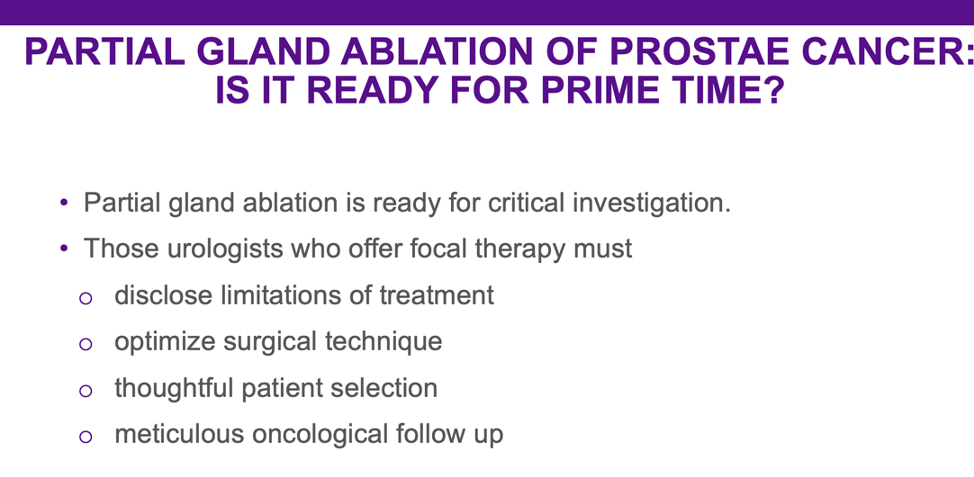Dr. Lepor started his talk by describing partial gland ablation of prostate cancer as the utilization of physical energy to destroy prostate cancer. The ablative energy may be delivered to the prostate by focusing the external energy source into the prostate or inserting an energy delivery system directly into the prostate. It is an outpatient procedure performed with or without general anesthesia, and fewer complications are noted than the standard whole gland treatment. There are various commercially available energy sources for partial gland ablation in the US, such as HIFU, cryotherapy, interstitial laser, irreversible electroporation, and brachytherapy. Radiofrequency and vascular photodynamic therapy are under development.
Dr. Lepor then highlighted the potential advantages of partial gland ablation for prostate cancer. It is targeted therapy, which can be repeated. It is an outpatient procedure, which lowers overall healthcare costs and causes less injury to peri-prostatic structures, and induces an anti-tumor immune response.
Dr. Lepor then put forward the case for prostate gland ablation. He mentioned that an index tumor typically defines the aggressiveness of prostate cancer. MRI identifies the index cancer in candidates for prostate gland ablation, and candidates for prostate gland ablation rarely have significant prostate cancer outside the ablation zone. Gleason Grade Group 1 and a select Gleason Grade Group 2 cases, who are also candidates for active surveillance (AS), are ideal candidates for prostate gland ablation. Prostate gland ablation destroys in-field prostate cancer. Preserving the quality of life is a high priority for men with clinically localized prostate cancer, and prostate gland ablation is an attractive modality for them.
Dr. Lepor then discussed the selection criteria for prostate gland ablation, which includes pre-treatment high-quality multiparametric MRI, Gleason grade < 8 disease concordant with the MRI lesion, absence of Gleason pattern 4 in the contralateral systemic biopsy, no gross extracapsular extension, no apical MRI lesion extending to extreme distal prostate.
Dr. Lepor then highlighted a study from their center, which looked at 59 men who would be candidates for focal ablation and underwent radical prostatectomy. Radical prostatectomy specimens were examined for Gleason pattern 4 disease outside focal ablation templates. Only in 20% of cases, they would have left any unrecognized Gleason pattern 4, and in all cases, it was less than 1mm.
Dr. Lepor then presented the oncological outcomes at six months following prostate gland cryoablation from their center. Seventy-three men met predefined criteria and underwent partial gland cryoablation. All patients got an MRI of the ablation zone and target biopsies of the ablation zone + ipsilateral systematic biopsies. They found that only one patient had clinically significant in-field disease, and they now no longer recommend reflex biopsy at six months. Functional outcomes were also excellent, with only some decrease in semen volume and modest short-term decrease in erectile function in some men, which was often restored with PDE5i therapy.
Dr. Lepor then discussed the post-ablation management at their center. The catheter is removed one to three days, depending on the extent of ablation, prostate volume, and baseline lower urinary tract symptoms (LUTS). Prostate-specific antigen (PSA) is performed every three months for the first year and then every six months. MRI is performed at 6 months, 2 years, 3.5 years, and 5 years. A prostate biopsy is performed at 2 and 5 years. For-cause biopsy is performed based on PSA velocity and MRI findings. They are currently investigating a pilot study looking at PET-MRI at two years to determine if a biopsy is needed.
Dr. Lepor then highlighted a recent study looking at HIFU and Cryotherapy partial gland ablation. One-year overall survival was 100%- and 5-year overall survival was 98.6%. Prostate cancer-specific survival was 100% at 1-year and 5-years. Metastasis-free survival was 99.7% at 1-year and 98.4% at 5-years. 67% of the patients were free from any radical treatment at the end of five years.
Dr. Lepor also presented 5-year outcomes following laser partial gland ablation but believed that laser is an outdated energy delivery system because of the availability of only one fiber related to its expense. Ten out of thirty patients had in-field recurrence, and 37% of the patients underwent salvage partial gland ablation. Five out of thirty patients had treatment failure and required whole gland treatment.
Dr. Lepor then discussed the optimization of partial gland ablation outcomes with training, patient selection, meticulous technique, and rigorous oncological assessment. He also highlighted the limitations of partial gland ablation, such as the optimal energy source, the extent of the ablation zone, post-ablation assessment of oncological control, and intermediate or long-term oncological outcomes.
Dr. Lepor concluded his talk with a summary, as seen in the slide below.
Presented by: Herbert Lepor, MD, The Martin Spatz Chair, Professor of Urology, Department of Urology, New York University (NYU) Grossman School of Medicine, New York City, New York
Written by: Abhishek Srivastava, MD, Urologic Oncologist, Atlantic Urology Clinics and Carolina Urology Research Center, Myrtle Beach, South Carolina, Twitter: @shekabhishek at the 2020 Prostate Cancer Academy, October 1st - 3rd, 2020 in Atlanta, Georgia


